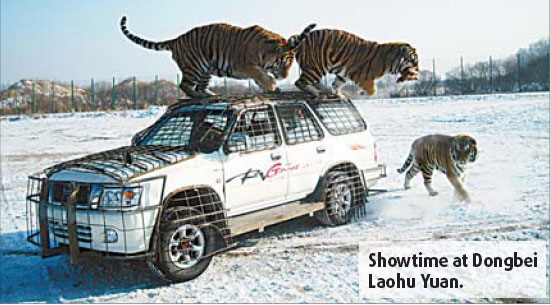While most wintertime holidaymakers rush south to balmy beaches, Harbin provides the polar opposite type of vacation destination.
The capital of Heilongjiang province is located about 400 km south of Siberia, as the arctic wind blows. Its frigid climate makes the city a hotspot for travelers during the annual Harbin International Snow and Ice Festival, but there's much more to this winter wonderland.
Harbin
is home to the world's largest Siberian tiger reserve, Dongbei Laohu Yuan, and a trip to this park provides a real ride on the wild side.
Visitors board a small bus ($9) that sputters through the tall, chain-link gates of the tigers' range. More than 800 of the endangered cats dwell among the park's 10 districts, and none of them seem shy. Once inside, the bus starts slaloming among the tigers, as if they were big, stripy traffic cones with claws and fangs.
Next, a SUV, encased in black caging, appears and also starts zipping to and fro among the tigers. The powerful predators know this is their dinner train and immediately give chase.
After a few minutes, the driver brakes and whips open the door to loft a live chicken into the air above the vehicle. A pouncing tiger intercepts the condemned cockerel mid-air - a blur of fur, a flash of feathers, and it's all over. It chows down on its prize atop the SUV.
Visitors can also purchase a live sheep for 600 yuan ($83) or even a cow for 1,500 ($208).
Lee Chak Lam, of Hong Kong, and his travel-mates Lau Chi Shan and Poon Pin Shan, of Shanghai, pooled their money with three strangers they met at the park to purchase a sheep.
"It was killed in a second," says a wide-eyed Lee. He believes it was money well spent.
After touring all of the ranges, visitors disembark from the bus to walk along a more conventionally zoo-like corridor of cages warehousing several species of big cats, including white tigers, lions, ligers, cheetahs and jaguars.
Harbin served as Russia's headquarters during its invasion of Manchuria, but it remained a small fishing village on the banks of the Songhua River until it was flooded with Russian refugees during the Bolshevik Revolution.
The city retains its reputation as "China's Moscow" and influences can be seen in many of the city's structures. The cornerstone of the city's architectural offerings is St Sophia Orthodox Church. Built in 1907, the building today serves as Harbin's Architecture and Art Center, displaying about 200 historical photographs and a handful of artifacts from olden times.
Architecture aficionados will enjoy a stroll along Zhongyang Dajie. This cobblestone street is flanked by rows of historical structures crowned with scalloped domes, copulas and spires. Today, they warehouse stores, restaurants and cafes proffering Russian wares.
(China Daily by Erik Nilsson January 31, 2008)


